+ データを開く
データを開く
- 基本情報
基本情報
| 登録情報 | データベース: PDB / ID: 2akr | |||||||||
|---|---|---|---|---|---|---|---|---|---|---|
| タイトル | Structural basis of sulfatide presentation by mouse CD1d | |||||||||
 要素 要素 |
| |||||||||
 キーワード キーワード | IMMUNE SYSTEM / NKT cells / CD1d / MHC fold / sulfatide / self-antigen / TCR | |||||||||
| 機能・相同性 |  機能・相同性情報 機能・相同性情報regulation of immature T cell proliferation in thymus / positive regulation of NK T cell activation / positive regulation of NK T cell differentiation / NK T cell differentiation / endogenous lipid antigen binding / antigen processing and presentation, exogenous lipid antigen via MHC class Ib / positive thymic T cell selection / positive regulation of macrophage activation / Endosomal/Vacuolar pathway / DAP12 interactions ...regulation of immature T cell proliferation in thymus / positive regulation of NK T cell activation / positive regulation of NK T cell differentiation / NK T cell differentiation / endogenous lipid antigen binding / antigen processing and presentation, exogenous lipid antigen via MHC class Ib / positive thymic T cell selection / positive regulation of macrophage activation / Endosomal/Vacuolar pathway / DAP12 interactions / Antigen Presentation: Folding, assembly and peptide loading of class I MHC / ER-Phagosome pathway / DAP12 signaling / Immunoregulatory interactions between a Lymphoid and a non-Lymphoid cell / antigen processing and presentation / positive regulation of interleukin-4 production / regulation of immune response / cellular defense response / T cell receptor binding / Neutrophil degranulation / positive regulation of interleukin-2 production / cellular response to iron(III) ion / negative regulation of forebrain neuron differentiation / antigen processing and presentation of exogenous protein antigen via MHC class Ib, TAP-dependent / iron ion transport / peptide antigen assembly with MHC class I protein complex / regulation of iron ion transport / regulation of erythrocyte differentiation / HFE-transferrin receptor complex / response to molecule of bacterial origin / MHC class I peptide loading complex / T cell mediated cytotoxicity / positive regulation of T cell cytokine production / antigen processing and presentation of endogenous peptide antigen via MHC class I / MHC class I protein complex / positive regulation of receptor-mediated endocytosis / negative regulation of neurogenesis / cellular response to nicotine / positive regulation of T cell mediated cytotoxicity / multicellular organismal-level iron ion homeostasis / positive regulation of type II interferon production / phagocytic vesicle membrane / negative regulation of epithelial cell proliferation / sensory perception of smell / positive regulation of cellular senescence / late endosome / T cell differentiation in thymus / negative regulation of neuron projection development / protein refolding / protein homotetramerization / amyloid fibril formation / intracellular iron ion homeostasis / learning or memory / early endosome / lysosome / endosome membrane / lysosomal membrane / innate immune response / external side of plasma membrane / structural molecule activity / Golgi apparatus / protein homodimerization activity / extracellular space / cytosol 類似検索 - 分子機能 | |||||||||
| 生物種 |  | |||||||||
| 手法 |  X線回折 / X線回折 /  シンクロトロン / シンクロトロン /  分子置換 / 解像度: 1.9 Å 分子置換 / 解像度: 1.9 Å | |||||||||
 データ登録者 データ登録者 | Zajonc, D.M. / Halder, R. / Wu, D. / Maricic, I. / Roy, K. / Wong, C.-H. / Kumar, V. / Wilson, I.A. | |||||||||
 引用 引用 |  ジャーナル: J.Exp.Med. / 年: 2005 ジャーナル: J.Exp.Med. / 年: 2005タイトル: Structural basis for CD1d presentation of a sulfatide derived from myelin and its implications for autoimmunity 著者: Zajonc, D.M. / Maricic, I. / Wu, D. / Halder, R. / Roy, K. / Wong, C.-H. / Kumar, V. / Wilson, I.A. | |||||||||
| 履歴 |
| |||||||||
| Remark 999 | SEQUENCE The Swiss-Prot entry P11609 conflicts with Bradbury et al., 1988 which suggests a ...SEQUENCE The Swiss-Prot entry P11609 conflicts with Bradbury et al., 1988 which suggests a histidine in place of aspartate. Author sequence agrees with the citation. |
- 構造の表示
構造の表示
| 構造ビューア | 分子:  Molmil Molmil Jmol/JSmol Jmol/JSmol |
|---|
- ダウンロードとリンク
ダウンロードとリンク
- ダウンロード
ダウンロード
| PDBx/mmCIF形式 |  2akr.cif.gz 2akr.cif.gz | 334.3 KB | 表示 |  PDBx/mmCIF形式 PDBx/mmCIF形式 |
|---|---|---|---|---|
| PDB形式 |  pdb2akr.ent.gz pdb2akr.ent.gz | 271.1 KB | 表示 |  PDB形式 PDB形式 |
| PDBx/mmJSON形式 |  2akr.json.gz 2akr.json.gz | ツリー表示 |  PDBx/mmJSON形式 PDBx/mmJSON形式 | |
| その他 |  その他のダウンロード その他のダウンロード |
-検証レポート
| 文書・要旨 |  2akr_validation.pdf.gz 2akr_validation.pdf.gz | 1.2 MB | 表示 |  wwPDB検証レポート wwPDB検証レポート |
|---|---|---|---|---|
| 文書・詳細版 |  2akr_full_validation.pdf.gz 2akr_full_validation.pdf.gz | 1.2 MB | 表示 | |
| XML形式データ |  2akr_validation.xml.gz 2akr_validation.xml.gz | 39.9 KB | 表示 | |
| CIF形式データ |  2akr_validation.cif.gz 2akr_validation.cif.gz | 57.9 KB | 表示 | |
| アーカイブディレクトリ |  https://data.pdbj.org/pub/pdb/validation_reports/ak/2akr https://data.pdbj.org/pub/pdb/validation_reports/ak/2akr ftp://data.pdbj.org/pub/pdb/validation_reports/ak/2akr ftp://data.pdbj.org/pub/pdb/validation_reports/ak/2akr | HTTPS FTP |
-関連構造データ
| 関連構造データ |  1z5lS S: 精密化の開始モデル |
|---|---|
| 類似構造データ |
- リンク
リンク
- 集合体
集合体
| 登録構造単位 | 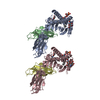
| ||||||||
|---|---|---|---|---|---|---|---|---|---|
| 1 | 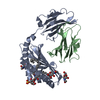
| ||||||||
| 2 | 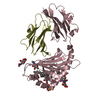
| ||||||||
| 3 | 
| ||||||||
| 4 | 
| ||||||||
| 単位格子 |
| ||||||||
| 詳細 | heterodimer formed by CD1d and beta-2-microglobulin |
- 要素
要素
-タンパク質 , 2種, 4分子 ACBD
| #1: タンパク質 | 分子量: 32632.668 Da / 分子数: 2 / 断片: extracellular domain, residues 19-297 / 由来タイプ: 組換発現 / 由来: (組換発現)  発現宿主:  株 (発現宿主): SF9 cells / 参照: UniProt: P11609 #2: タンパク質 | 分子量: 11660.350 Da / 分子数: 2 / 断片: residues 21-119 / 由来タイプ: 組換発現 / 由来: (組換発現)  発現宿主:  株 (発現宿主): SF9 cells / 参照: GenBank: 55153801, UniProt: P01887*PLUS |
|---|
-糖 , 2種, 6分子 
| #3: 多糖 | 2-acetamido-2-deoxy-beta-D-glucopyranose-(1-4)-2-acetamido-2-deoxy-beta-D-glucopyranose |
|---|---|
| #4: 糖 | ChemComp-NAG / |
-非ポリマー , 2種, 750分子 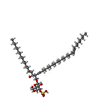


| #5: 化合物 | | #6: 水 | ChemComp-HOH / | |
|---|
-詳細
| Has protein modification | Y |
|---|
-実験情報
-実験
| 実験 | 手法:  X線回折 / 使用した結晶の数: 1 X線回折 / 使用した結晶の数: 1 |
|---|
- 試料調製
試料調製
| 結晶 | マシュー密度: 2.66 Å3/Da / 溶媒含有率: 53.8 % |
|---|---|
| 結晶化 | 温度: 277 K / pH: 6.5 詳細: ammonium sulfate, NaCl, sodium cacodylate, manganese chloride, pH 6.5, VAPOR DIFFUSION, SITTING DROP, temperature 277.0K, pH 6.50 |
-データ収集
| 回折 | 平均測定温度: 120 K |
|---|---|
| 放射光源 | 由来:  シンクロトロン / サイト: シンクロトロン / サイト:  SSRL SSRL  / ビームライン: BL11-1 / 波長: 0.97976 / ビームライン: BL11-1 / 波長: 0.97976 |
| 検出器 | タイプ: ADSC QUANTUM 315 / 検出器: CCD / 日付: 2005年4月15日 |
| 放射 | モノクロメーター: CURVED CRYSTAL / プロトコル: SINGLE WAVELENGTH / 単色(M)・ラウエ(L): M / 散乱光タイプ: x-ray |
| 放射波長 | 波長: 0.97976 Å / 相対比: 1 |
| 反射 | 解像度: 1.9→50 Å / Num. obs: 67171 / % possible obs: 98.7 % / Observed criterion σ(I): 0 / 冗長度: 2.4 % / Biso Wilson estimate: 19.8 Å2 / Rsym value: 0.089 / Net I/σ(I): 15.9 |
| 反射 シェル | 解像度: 1.9→1.97 Å / Mean I/σ(I) obs: 2.4 / Rsym value: 0.58 / % possible all: 99.7 |
- 解析
解析
| ソフトウェア |
| |||||||||||||||||||||||||||||||||||||||||||||||||||||||||||||||||||||||||||||||||||||||||||||||||||||||||||||||||||||||||||||||||||||||||||||||||||||||||||||||||||||||||||||||
|---|---|---|---|---|---|---|---|---|---|---|---|---|---|---|---|---|---|---|---|---|---|---|---|---|---|---|---|---|---|---|---|---|---|---|---|---|---|---|---|---|---|---|---|---|---|---|---|---|---|---|---|---|---|---|---|---|---|---|---|---|---|---|---|---|---|---|---|---|---|---|---|---|---|---|---|---|---|---|---|---|---|---|---|---|---|---|---|---|---|---|---|---|---|---|---|---|---|---|---|---|---|---|---|---|---|---|---|---|---|---|---|---|---|---|---|---|---|---|---|---|---|---|---|---|---|---|---|---|---|---|---|---|---|---|---|---|---|---|---|---|---|---|---|---|---|---|---|---|---|---|---|---|---|---|---|---|---|---|---|---|---|---|---|---|---|---|---|---|---|---|---|---|---|---|---|---|
| 精密化 | 構造決定の手法:  分子置換 分子置換開始モデル: PDB ENTRY 1Z5L 解像度: 1.9→41.38 Å / Cor.coef. Fo:Fc: 0.955 / Cor.coef. Fo:Fc free: 0.924 / SU B: 7.941 / SU ML: 0.118 / 交差検証法: THROUGHOUT / σ(F): 0 / ESU R: 0.152 / ESU R Free: 0.155 / 立体化学のターゲット値: MAXIMUM LIKELIHOOD
| |||||||||||||||||||||||||||||||||||||||||||||||||||||||||||||||||||||||||||||||||||||||||||||||||||||||||||||||||||||||||||||||||||||||||||||||||||||||||||||||||||||||||||||||
| 溶媒の処理 | イオンプローブ半径: 0.8 Å / 減衰半径: 0.8 Å / VDWプローブ半径: 1.2 Å / 溶媒モデル: MASK | |||||||||||||||||||||||||||||||||||||||||||||||||||||||||||||||||||||||||||||||||||||||||||||||||||||||||||||||||||||||||||||||||||||||||||||||||||||||||||||||||||||||||||||||
| 原子変位パラメータ | Biso mean: 27.481 Å2
| |||||||||||||||||||||||||||||||||||||||||||||||||||||||||||||||||||||||||||||||||||||||||||||||||||||||||||||||||||||||||||||||||||||||||||||||||||||||||||||||||||||||||||||||
| 精密化ステップ | サイクル: LAST / 解像度: 1.9→41.38 Å
| |||||||||||||||||||||||||||||||||||||||||||||||||||||||||||||||||||||||||||||||||||||||||||||||||||||||||||||||||||||||||||||||||||||||||||||||||||||||||||||||||||||||||||||||
| 拘束条件 |
| |||||||||||||||||||||||||||||||||||||||||||||||||||||||||||||||||||||||||||||||||||||||||||||||||||||||||||||||||||||||||||||||||||||||||||||||||||||||||||||||||||||||||||||||
| LS精密化 シェル | 解像度: 1.9→1.95 Å / Total num. of bins used: 20
| |||||||||||||||||||||||||||||||||||||||||||||||||||||||||||||||||||||||||||||||||||||||||||||||||||||||||||||||||||||||||||||||||||||||||||||||||||||||||||||||||||||||||||||||
| 精密化 TLS | 手法: refined / Refine-ID: X-RAY DIFFRACTION
| |||||||||||||||||||||||||||||||||||||||||||||||||||||||||||||||||||||||||||||||||||||||||||||||||||||||||||||||||||||||||||||||||||||||||||||||||||||||||||||||||||||||||||||||
| 精密化 TLSグループ |
|
 ムービー
ムービー コントローラー
コントローラー





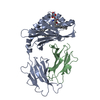

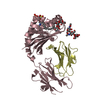
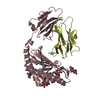

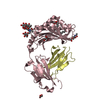

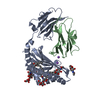
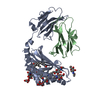
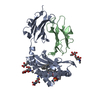

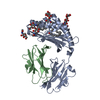
 PDBj
PDBj











